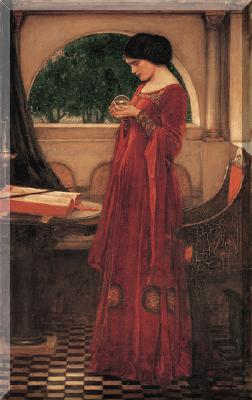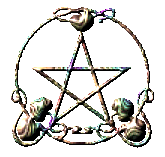|
|
Wicca Traditions

|

|

Alexandrian Wicca
As most everyone by now is aware, the Alexandrian Tradition is very close to
Gardnerian with a few minor changes. (One of the most obvious ones being that
the Alexandrians use the athame as a symbol for the element of fire and the
wand as a symbol for air. Most of the rituals are very formal and heavily
indebted to ceremonial magick. It is also a polarized tradition and the
sexuality of that female/male polarity is emphasized. The ritual cycle deals
mostly with the division of the year between the Holly King and the Oak King
and several ritual dramas deal with the dying/resurrected God theme. As with
Gardnerians, the High Priestess is supposedly the highest authority. However,
it is odd that the primary spokespersons for both traditions have been men.
[*This material provided by Gillan]
Alexandrian Wicca is the creation of Alex Sanders (with his then wife Maxine)
who claimed to have been initiated by his grandmother in 1933. It's principal
proponents are Janet and Stewart Fararr whose books set forth most, if not all,
of the Alexandrian tradition. Contrary to popular belief, the name Alexandrian
refers not to Alex Sanders, but to Ancient Alexandria.
Although similiar to Gardnerian Wicca, Alexandrian Wicca tends to be more
eclectic, and liberal. Some of Gardnerisms strict rules, such as the
requirement of ritual nudity, have been made optional by Alexandrian Wicca.
Mary Nesnick, an American initiate in Gardnerian and Alexandrian traditions
founded a 'new' tradition called Algard. This tradition brings together both
Gardnerian and Alexandrian teachings under a single banner. This was possible
due to the great similiarities between the two traditions.

Celtic Wicca (Church of Wicca)
The Church of Wicca was founded by Gavin and Yvonne Frost. They offer
correspondence courses in their brand of Wicca, which is sometimes called
Celtic Wicca. The Church of Wicca has just recently begun including a Goddess
in their diety structure, and has been very patrofocal as Wiccan traditions go.
The Chuch of Wicca terms itself "Baptist Wicca"
The Frosts call their tradition of Wicca Celtic. To me it seems more of a
mixture of high magic and eclectic Wicca, with a smattering of Celtic thrown
in. For instance, they use three circles, one within the others, made of salt,
sulphur and herbs with runes and symbols between them instead of just one
circle. They also insist on a white- handled athame and will not have a black
handled one, whereas all the other traditions I have heard or read about use a
black handled one. It seems to me the Wicca they practice and teach should not
be called Celtic at all; but since a lot of it is made up or put together by
them from other traditions they should also give it a made-up name; say
Frostism. If you DON'T have to pay for the course, and have some extra time, it
would probably be worth reading just for comparison. [*From Circe, who took
their correspondence course.]
The Frosts have always been rather more public than most traditions
(advertising their course in the Enquirer and similar publications) which has
earned them heavy criticism in less public Craft groups.

Dianic Wicca
The Dianic Craft includes two distinct branches:
1.
One branch, founded in Texas by Morgan McFarland and Mark Roberts, gives
primacy to the Goddess in its thealogy, but honors the Horned God as Her
Beloved Consort. Covens are mixed, including both womyn and men. This branch is
sometimes called 'Old Dianic', and there are still covens of this tradition,
especially in Texas. Other covens, similar in thealogy but not directly
descended from the McFarland/ Roberts line, are sprinkled around the country.
2.
The other branch, sometimes called Feminist Dianic Witchcraft, focus
exclusively on the Goddess and consists of womyn-only covens and groups. These
tend to be loosely structured and non-hierarchical, using consensus- decision-
making and simple, creative, experimental ritual. They are politically feminist
groups, usually very supportive, personal and emotionally intimate. There is a
strong lesbian presence in the movement, though most covens are open to womyn
of all orientations. The major network is Re-Formed Congregation of the
Goddess, which publishes "Of a Like Mind" newspaper and sponsors conferences on
Dianic Craft. [* Amber K]

Discordianism (Erisian)
The Discordian or Erisian movement is described as a 'Non- Prophet Irreligious
Disorganization' and has claimed 'The Erisian revelation is not a complicated
put-on disguised as a new religion, but a new religion disguised as a
complicated put-on. " It all started with the *'Principia Discordia, or How I
Found the Goddess and What I Did to Her When I Found Her'*, a collection of
articles and ideas compiled by Greg Hill (Malaclypse the Young-er). The central
theme is 'Chaos is every bit as important as Order' as illustrated in the story
of The curse of Greyface:
Humor is central to Discordianism, but Discordianism should not be dismissed as
a joke. Profound experiences frequently accompany the practice or Erisinaism.
It is a perceptual game, one which demonstrates that the absurd is just as
valid as the mundane and chaos is just as valid as order. It frees the
practitioner from the order games (that most have forgotten are games) to play
games with order or games with chaos, or both. The effects of Discordianism
upon an individual can be far- reaching and amazingly liberating. [Although a
great many immature individuals have played at Discordianism and thereby
sidestepped any chance of spiritual growth whatsoever -- Grey Cat *wryly*]

Gardnerian Wicca
A retired British civil servant named Gerald B. Gardner is the 'Grandfather',
at the very least, of almost all Neo-Wicca. He was initiated into a coven of
Witches in the New Forest region of England in 1939 by a High Priestess named
'Old Dorothy' Clutterbuck. In 1949 he wrote a novel [*High Magic's Aid*] about
medieval Witchcraft in which quite a bit of the Craft as practiced by that
coven was used. In 1951 the last of the English laws against Witchcraft were
repealed (primarily due to the pressure of Spiritualists) and Gardner published
*Witchcraft Today*, which set forth a version of the rituals and traditions of
that coven. There is an enormous amount of disagreement about virtually every
statement I have made in this paragraph.
Gardnerism is both a tradition and a family, and lineage is a family tree. The
High Priestess rules the coven, and the principles of love and trust preside.
We follow our handed down book more carefully than many others, but we are free
to add and improvise, as long as we preserve the original.
We work skyclad, practice binding and scourging, are hierarchal and secretive,
therefore we are controversial. We're also controversial because we were first
- the first craft tradition in the U. S. and descended from the man largely
responsible for starting the craft revival. So, we're called 'the snobs of the
craft', but I think we're as much fun as anyone else; our parties as good, our
jokes as bad'
A Gardnerian can trace his/her lineage matrilineally back to a High Priestess
who worked with Gerald. For virtually all American Gardnerians, that means his
last HPS, Monique Wilson. Monique initiated the Bucklands and Rosemary Buckland
initiated Theos, so far as anyone knows, the only one of Rosemary's Thirds who
passed the initiation on.' [the foregoing quotes provided by Deborah Lipp, a
Gardnerian Third Degree High Priestess as well as an ADF Druidess.]
Each Gardnerian coven is autonomous and is headed by a High Priestess who can
turn to her queen (the High Priestess who trained her) for counsel and advice.
This maintains the lineage and creates a pool of experienced and knowledgeable
leaders and teachers.
Reincarnation and the Wiccan Rede [An it harm none do what you will] are basic
tenants of the tradition. Covens are as much as possible composed of
male/female pairs for balance. Most working is accomplished with the energy
raised by the interaction of the Lord and Lady as represented by the couples in
the coven by dancing, chanting, etc.
Like many Wiccan traditions, Gardnerians have three degrees. An American
Gardnerian must be of the 3rd degree before she can become a HPS. The HPS/HP
are responsible for conducting services (circles), training their conveners,
and preserving and passing on Gardnerian Craft. *[This material quoted from
Converging Paths Newsletter, Kyril, Brita, & Hugh authors. ]
A lot of the controversy surrounding Gardnerianism questions the sources of the
rituals and other materials, particularly those appearing in print. It is true
that Gardner presented these materials as if they were directly from his New
Forest tradition. It is clear, however, that whatever materials the coven may
have had when he was initiated, Gerald made a lot of changes and added a great
deal. Literary sources of the published Book of Shadows include Blake, Kipling,
Yeats and Crowley. Much of the published material was written by Doreen
Valiente, a member of the coven for a time and later founder of her own groups
and author of many excellent books on the Craft.
Gardnerian Witches without doubt do have many materials which have not appeared
in print, however, their emphasis on secrecy has made them a punchline in the
Wiccan social world. How many Gardnerians does it take to change a light bulb?
That's a secret! Their High Priestess will usually be called 'Lady' Soandso and
High Priest, 'Lord Whatisname'. [This is far more true in the U. S. than it is
in England.]

Georgian Wicca
If one word could best describe the Georgean Tradition, it would be 'eclectic'.
Even though the material provided to students was nominally Alexandrian, there
was never any imperative to follow that path blindly. George Patterson (the
tradition's founder) always said 'If it works use it, if it doesn't, don't'.
The newsletter was always full of contributions from people of many traditions.
I've always felt Pat's intent was to provide jumping off points for students
and members. So even though I can claim initiation into more than one
tradition, I'll always consider myself 'Georgian' first: George is greatly
missed, may the God-dess watch over him. Bright Blessings, Lord Fafner.
Source Unknown

Site copyright�1999 by Dashiel
|